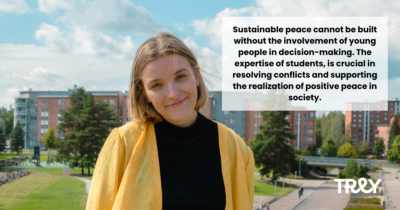I dare to claim that I am currently not the only student concerned about the state of the world. Various crises and conflicts, especially in Ukraine and Palestine, dominate every news broadcast and fill the screens of our phones on social media. This flood of news can easily overwhelm and depress.
An article in Helsingin Sanomat on September 5th highlights statistics from the Uppsala Conflict Data Program (UCDP), stating that last year was the bloodiest in nearly 30 years. In 2022, 1.2 billion people lived in areas affected by violent conflicts. This is 14 percent of the world’s population.
In the face of major global conflicts, it is time to talk about peace.
What is peace? The Peace Education Institute divides the term of peace into two categories: negative peace and positive peace. Negative peace refers to the absence of direct violence and conflicts. Positive peace, on the other hand, refers to the absence of indirect violence. In this state, individuals can participate in society, feel secure, and individuals or groups are not discriminated against.
And how does all of this relate to students and the student movement?
Sustainable peace cannot be built without the involvement of young people and future generations in decision-making. The expertise of students, for example in education, equality, combating racism, and more broadly in themes of sustainable development, is crucial in resolving conflicts and supporting the realization of positive peace in society.

The student movement also has a global responsibility. In this regard, development cooperation and humanitarian aid have a significant impact on ensuring peace on a global level. As mentioned earlier, the student movement has extensive knowledge in education, its equality, and accessibility. By combining the expertise of students, both in Finland and partner countries, we can support accessible education in fragile societies. In this way, we are also strengthening global peace.
Young people or students, both globally and in Finland, should not only be seen as victims but as active builders of peace in various processes. In a world of crises and conflicts, one can easily become desensitized. Instead of that, students and, more broadly, young people deserve to have faith in a better future and the opportunity to influence it. Peace work and peace are key factors in this.
Sources:
Rauha – Rauhankasvatusinstituutti
Maailman sodissa kuoli viime vuonna eniten ihmisiä 30 vuoteen